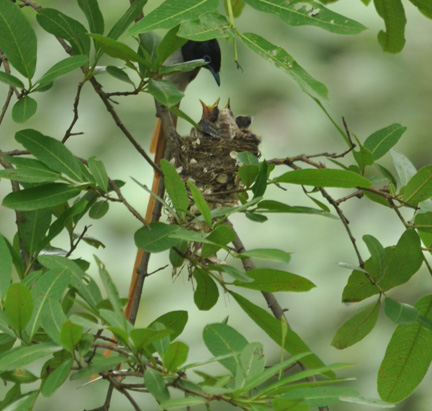On the Nesting of the State bird of Madhya Pradesh
By Ajay Gadikar
The Indian paradise flycatcher (Terpsiphoneparadisi)is the state bird of M.P. This beautiful bird is found practically throughout the country. I will like to share my observations regarding the nesting behaviour of the paradise flycatcher. This bird
is a local migrant in this part of the country, arriving in March and staying till August end. Its breeding behaviour is studied by me at the Kajligarh Forest area near Indore.
Generally, I used to go with three more birders in my endeavours, my wife and son, as both of them have quite a lot interest in bird watching and my friend Pravar a young chap who is also a good bird watcher and photographer. We generally used to start
at 6:00 am on Sundays from our home to watch this beautiful beauty in the valleys of Kajligarh Forest where they nest each year.
We used to reach the forest area around 7:00 am as the place is about 30 kms. from Indore city. It is famous for its old fort which is now in ruins; the fort is situated on top of the hill and our area of observation was the various valleys surrounding
the hills. In this valley, during the monsoon season many water streams are formed and along these streams many birds can be seen. The birds come here during the summer season and just before the onset of monsoon starts preparing the nest to breed and bring
their next progeny.
It’s a mixed deciduous type of forest, with teak trees dominating the major area, apart from various varieties of teak trees the other major trees found are Palash and Arjun.
We descend into the valley carefully through a makeshift staircase prepared by the forest department. An age old lord Shiva temple is situated beneath a rock here, near the temple a small gorge is created by the water falling from upside. A stream is
formed by the overflow of the water, we follow the stream and look for the birds on the trees alongside it. Most of the shrubs areof Lantana plant which grows on both sides of the stream. At some point we need to cross the river stream and go on the other
side due to very thick vegetation with no further access possible.
As the forest canopy is very dense in the valley and the light conditions are also dull, the birds are not always visible. Most of the birds are heard rather than seen here. One can see birds feeding on the fruiting tree up in the canopy, the mixed hunting
party of babblers, woodpeckers, orioles and drongos are seen foraging from one tree to another.
The main attraction of our visit to Kajligarh forest area just before the monsoon is to see the nesting behaviour of the paradise flycatcher. The Paradise flycatcher males are seen in two colours, the ruffous color and the white color. The rufous ones
are younger than the white color males. The males also possess a long tail which is absent in females. In the month of April one can see the courtship rituals of the male and female. The rival males can be seen chasing each other to establish their territory.
Once the territory is secured and successful mating is done, both the sexes participate in nest building but the female majorly contributes. They carefully choose a branch of the tree which can withstand the heavy rains
and strong wind. The nest is cup shaped and generally can be seen easily tied on a tree branch just above a water stream.
Each year just before the onset of monsoon one can see many pairs of paradise flycatchers building their nest, then both the parents incubate the eggs. It takes around 20-22 days for the eggs to hatch, and as soon as the young ones come out of the eggs,
both of them start feeding the babies. The chicks become restless with the arrival of their parents at the nest and stretch their beaks to the fullest to grab the food.

It didn’t take us long to spot the nest of a paradise flycatcher in which the chicks got hatched a couple of days earlier and were ready to fledge any day. Observing the nest quietly from a safe distance, we could see the Male and Female bird arriving
silently at the nest and feeding the chicks. It was wonderful to observe the behaviour. We noted them bringing various insects at a quite fast pace as they need to cater to the demand of those four highly demanding babies. The breeding process ends by August
each year and the young ones can be seen moving around with their mother in the vicinity for a few more days.

The reason for breeding at this time of the year is the richness of food. With the arrival of Monsoon and the subsequent rains causing dampness in the forest, an abundant supply of insects and different species of flies become available. This is the
time of the year when most of the forest birds breed, specially flycatcher family birds, as there is ample supply of protein food in the form of insects. Many of the flycatcher family bird nests can be seen at this time. At the same time, some other flycatchers
are also seen hatching the eggs or feeding the young ones while the latecomers are still seen preparing of the nest.
I had been visiting the Kajligarh forest area since last many years and found that many resident species of birds live here and many summer migrants also visit here for breeding purposes. Areas like these should be protected and conserved so that upcoming
generations of these bird species should find a place to live and flourish.
(Text and Pictures Ajay Gadikar, a naturalist from Indore)